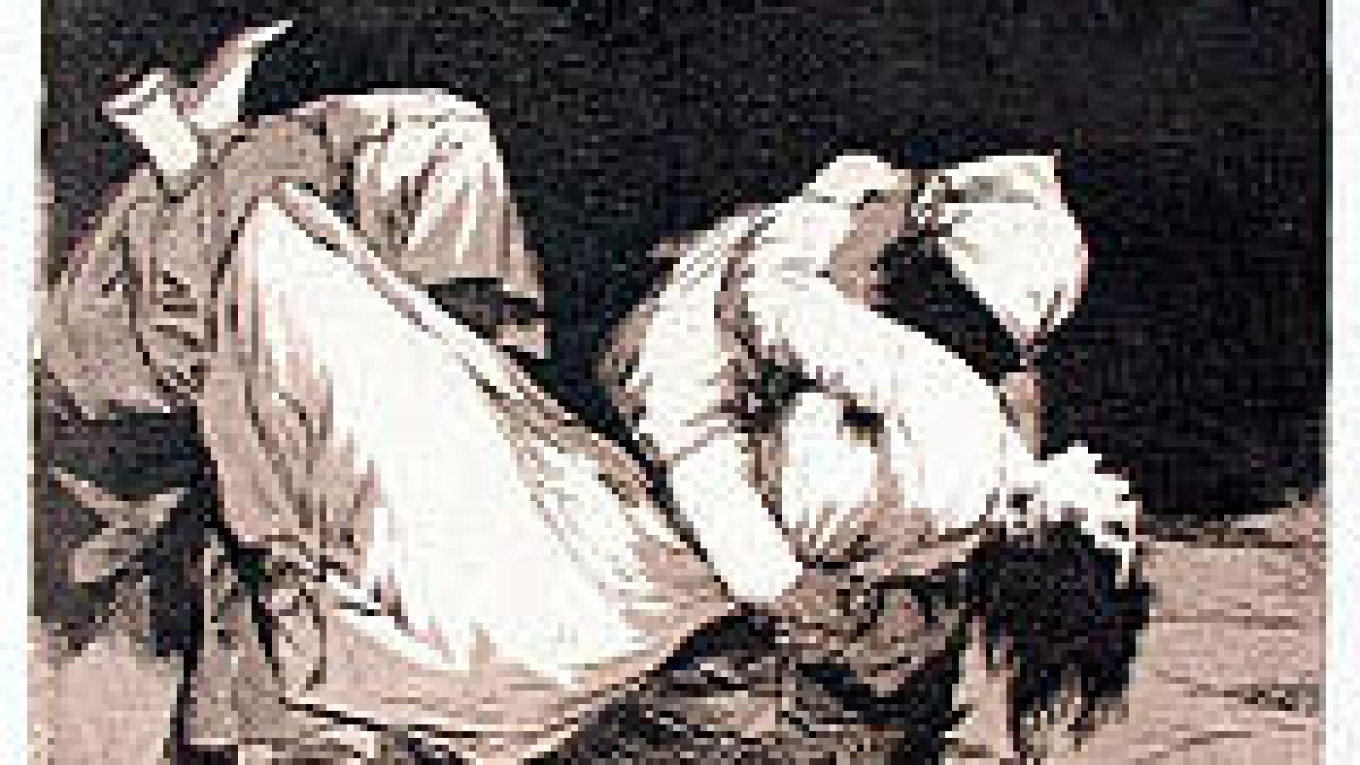Goya was an aberration in Spanish art. He was born in 1746 and died in 1828 and therefore lived during the period when the extravagant Rococo style gave way to the stricter formality of the Enlightenment. He was influenced by both movements, but he had an inimitable style of his own that was given full voice in this extraordinary series of etchings.
In the late 18th century, Goya was a court painter for the Spanish royal family in Madrid and was expected to flatter his subjects. However, as he became more acquainted with court life, he began to see its corruption, and a gentle satire entered his paintings. He realized that imbeciles are sometimes born to royal parents and he began to paint his young subjects as such. This can been seen in Los Caprichos, where he draws a monkey painting a donkey, and on the canvas the donkey has been given a glossy wig.
By the time he turned his hand to Los Caprichos, he had been deaf for six years, and his mistrust of the world had deepened. Here, his satire found full expression and was directed at every possible target. The exhibition room at the Cervantes Cultural Center is transformed into a parade of the follies and whims of man, a theme not unfamiliar to present-day viewers.
They are not moral pictures, however; Goya rejected the Enlightenment understanding of what was considered "right" or "sensible" and lived in an anarchic world of his own. When Los Caprichos were originally published, the executors of the Inquisition, the brutal drive to root out "heretics" in Spain that began in 1478 and only officially ended in 1808, seized the metal plates on which Goya had made the etchings, making it impossible for him to reproduce them and leaving only a few complete sets in existence. Etchings, as things that could be reproduced, were an early form of mass media, and Goya's work was dangerous to the authorities as he parodied and mocked the officials of the Inquisition, recognizable in the etchings from their tall pointy hats.
The first picture in the series is a profile of the artist, jaded and weary, not quite looking straight ahead and not quite meeting the onlooker's eye. This ambiguity is ever present in the series. A portrait of unhappy lovers in "Love and Death" comes only two etchings before "Hunting for Teeth," which shows a woman with a horrified expression wrenching the gold teeth from the mouth of a man hanging dead on the gallows. Every sketch elicits a different reaction, and each, even those depicting the darkest and most grotesque visions, are exquisitely rendered.
Some of the most frightening are those of witches. Goya liked women, painting young ladies with sweet faces and pretty feet. He even liked witches, because at the time of the Inquisition when the usual punishment for witchcraft was death, they seemed to Goya to exist outside the law and outside religion and so were free of the usual restraints. His witches wrestle with broomsticks, gather naked on beaches under starry skies and fight each other in space while giant cats watch.
Chiaroscuro, the use of light and shade to produce an illusion of depth, brings drama to the artist's pictures. In what is probably the most famous etching of the series, "The Sleep of Reason Produces Monsters," a man sits in the bright foreground at a desk with his head in his hands while owls and lynxes swoop out of the darkness behind him. Because the man's face is hidden, he is commonly supposed to be the artist being visited by the demons of the subconscious, which Freud would write about over 200 years later.
Beside the witches and the donkeys and the tragic lovers, Los Caprichos is made up of vignettes of everyday life. Art critic Robert Hughes describes Goya as having an "encyclopedic curiosity about character," and he is interested in situations which seem unexciting, but in his hands are filled with life with all its ambiguities, and set the imagination of the onlooker whirring with fantasy. This exhibition is a rarity and now is a great time to see it, while the moon is full, and the witching hour is here. ...
Los Caprichos runs to the end of March at the Cervantes Cultural Center, located at 20A Novinsky Bulvar. Metro Barrikadnaya. Tel. 937-1952.
A Message from The Moscow Times:
Dear readers,
We are facing unprecedented challenges. Russia's Prosecutor General's Office has designated The Moscow Times as an "undesirable" organization, criminalizing our work and putting our staff at risk of prosecution. This follows our earlier unjust labeling as a "foreign agent."
These actions are direct attempts to silence independent journalism in Russia. The authorities claim our work "discredits the decisions of the Russian leadership." We see things differently: we strive to provide accurate, unbiased reporting on Russia.
We, the journalists of The Moscow Times, refuse to be silenced. But to continue our work, we need your help.
Your support, no matter how small, makes a world of difference. If you can, please support us monthly starting from just $2. It's quick to set up, and every contribution makes a significant impact.
By supporting The Moscow Times, you're defending open, independent journalism in the face of repression. Thank you for standing with us.
Remind me later.


